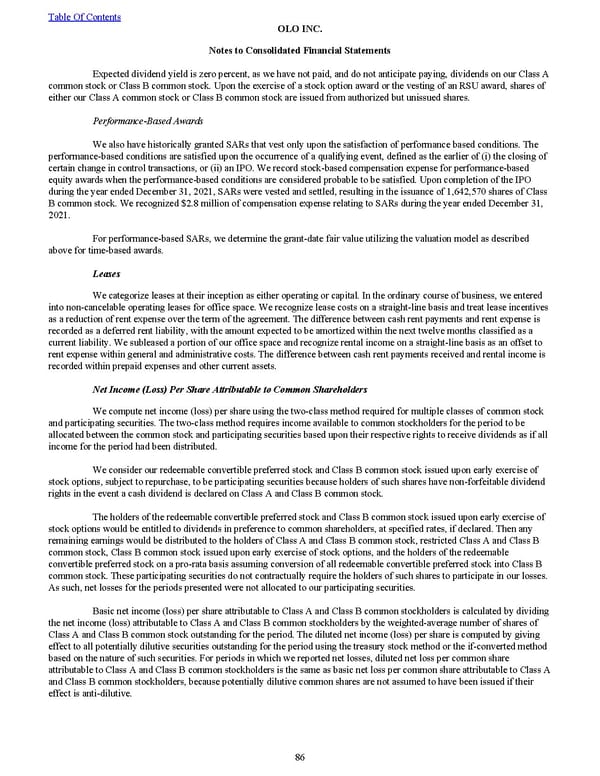Expected dividend yield is zero percent, as we have not paid, and do not anticipate paying, dividends on our Class A common stock or Class B common stock. Upon the exercise of a stock option award or the vesting of an RSU award, shares of either our Class A common stock or Class B common stock are issued from authorized but unissued shares. Performance-Based Awards We also have historically granted SARs that vest only upon the satisfaction of performance based conditions. The performance-based conditions are satisfied upon the occurrence of a qualifying event, defined as the earlier of (i) the closing of certain change in control transactions, or (ii) an IPO. We record stock-based compensation expense for performance-based equity awards when the performance-based conditions are considered probable to be satisfied. Upon completion of the IPO during the year ended December 31, 2021, SARs were vested and settled, resulting in the issuance of 1,642,570 shares of Class B common stock. We recognized $2.8 million of compensation expense relating to SAR s during the year ended December 31, 2021 . For performance-based SARs, we determine the grant-date fair value utilizing the valuation model as described above for time-based awards. Leases We categorize leases at their inception as either operating or capital. In the ordinary course of business, we entered into non-cancelable operating leases for office space. We recognize lease costs on a straight-line basis and treat lease incentives as a reduction of rent expense over the term of the agreement. The difference between cash rent payments and rent expense is recorded as a deferred rent liability, with the amount expected to be amortized within the next twelve months classified as a current liability. We subleased a portion of our office space and recognize rental income on a straight-line basis as an offset to rent expense within general and administrative costs . The difference between cash rent payments received and rental income is recorded within prepaid expenses and other current assets. Net Income (Loss) Per Share Attributable to Common Shareholders We compute net income (loss) per share using the two-class method required for multiple classes of common stock and participating securities. The two-class method requires income available to common stockholders for the period to be allocated between the common stock and participating securities based upon their respective rights to receive dividends as if all income for the period had been distributed. We consider our redeemable convertible preferred stock and Class B common stock issued upon early exercise of stock options, subject to repurchase, to be participating securities because holders of such shares have non-forfeitable dividend rights in the event a cash dividend is declared on Class A and Class B common stock. The holders of the redeemable convertible preferred stock and Class B common stock issued upon early exercise of stock options would be entitled to dividends in preference to common shareholders, at specified rates, if declared. Then any remaining earnings would be distributed to the holders of Class A and Class B common stock, restricted Class A and Class B common stock, Class B common stock issued upon early exercise of stock options, and the holders of the redeemable convertible preferred stock on a pro-rata basis assuming conversion of all redeemable convertible preferred stock into Class B common stock. These participating securities do not contractually require the holders of such shares to participate in our losses. As such, net losses for the periods presented were not allocated to our participating securities. Basic net income (loss) per share attributable to Class A and Class B common stockholders is calculated by dividing the net income (loss) attributable to Class A and Class B common stockholders by the weighted-average number of shares of Class A and Class B common stock outstanding for the period. The diluted net income (loss) per share is computed by giving effect to all potentially dilutive securities outstanding for the period using the treasury stock method or the if-converted method based on the nature of such securities. For periods in which we reported net losses, diluted net loss per common share attributable to Class A and Class B common stockholders is the same as basic net loss per common share attributable to Class A and Class B common stockholders, because potentially dilutive common shares are not assumed to have been issued if their effect is anti-dilutive. Table Of Contents OLO INC. Notes to Consolidated Financial Statements 86
 2022 10K Page 92 Page 94
2022 10K Page 92 Page 94